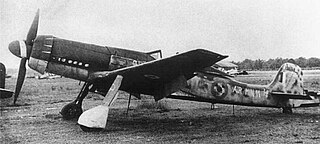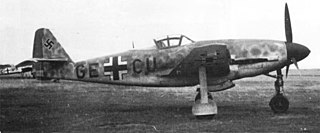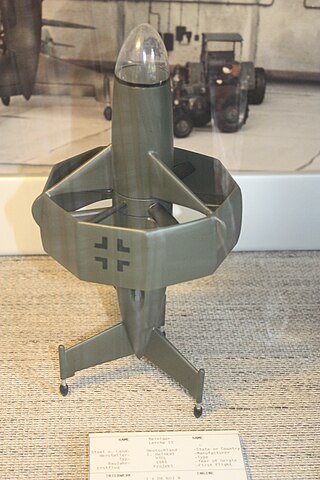Related Research Articles

The Focke-Wulf Ta 154 Moskito was a fast twin-engined German night fighter aircraft designed by Kurt Tank and produced by Focke-Wulf during late World War II. Only a few were produced, proving to have less impressive performance than the prototypes.

The Messerschmitt Bf 110, often known unofficially as the Me 110, is a twin-engined Zerstörer, fighter-bomber, and night fighter (Nachtjäger) developed in Nazi Germany in the 1930s and used by the Luftwaffe during World War II. Hermann Göring was a proponent of the Bf 110, believing its heavy armament, speed, and range would make the Bf 110 the Luftwaffe’s premier offensive fighter. Early variants were armed with two MG FF 20 mm cannon, four 7.92 mm MG 17 machine guns, and one 7.92 mm MG 15 machine gun for defence. Development work on an improved type to replace the Bf 110 - the Messerschmitt Me 210 - began before the war started, but its shakedown troubles resulted in the Bf 110 soldiering on until the end of the war in various roles. Its intended replacements, the aforementioned Me 210 and the significantly improved Me 410 Hornisse, never fully replaced the Bf 110.

The Focke-Wulf Fw 187 Falke ("Falcon") was a German aircraft designed in 1935. It was conceived by Kurt Tank as a twin-engine, high-performance fighter, but the Luftwaffe saw no role for the design, perceiving it as intermediate between the Messerschmitt Bf 109 and Bf 110. Later prototypes were adapted to two-seats to compete with the Bf 110 in the heavy fighter (Zerstörer) role, but only nine aircraft were built in total.

The Focke-Wulf Ta 152 is a World War II German high-altitude fighter–interceptor designed by Kurt Tank and produced by Focke-Wulf. The Ta 152 was a development of the Focke-Wulf Fw 190 aircraft. It was intended to be made in at least three versions—the Ta 152H Höhenjäger ; the Ta 152C designed for medium-altitude operations and ground-attack, using a Daimler-Benz DB 603 and with smaller wings and the Ta 152E fighter–reconnaissance aircraft with the engine of the H model and the wing of the C model. The first Ta 152H entered service with the Luftwaffe in January 1945. The Ta 152 was produced too late and in insufficient numbers to have a significant role in the war.

The Messerschmitt Me 328 was a prototype pulsejet-powered fighter aircraft designed and produced by the German aircraft manufacturer Messerschmitt AG.

The Focke-Wulf Fw 191 was a prototype German bomber of World War II, as the Focke-Wulf firm's entry for the Bomber B advanced medium bomber design competition. Two versions were intended to be produced, a twin-engine version using the Junkers Jumo 222 engine and a four-engine variant which was to have used the smaller Daimler-Benz DB 605 engine. The project was eventually abandoned due to technical difficulties with the engines.

The Me 209 of 1943 was an attempt to create an enhanced version of the Bf 109, which served as the Luftwaffe's primary fighter aircraft throughout World War II. The Me 209, despite its designation, bore no relationship to the earlier Me 209.

The Messerschmitt Me 309 was a prototype German fighter, designed in the early years of World War II to replace the Messerschmitt Bf 109. Although it had many advanced features, the Me 309's performance left much to be desired and it had so many problems that the project was cancelled with only four prototypes built. The Me 309 was one of two failed Messerschmitt projects intended to replace the Bf 109, the other being the 1943 Me 209 project.
The Focke-Wulf Ta 153 (GH+KV) was a prototype German fighter aircraft built during World War II. It was a development of the Fw 190C, a Fw 190A with a DB 603A engine.

The Focke-Wulf Fw 57 was a prototype German heavy fighter and fighter-bomber. Prototypes were built in 1936 but never entered production.

The Dornier Do 317 was a prototype German medium bomber of World War II.

The Henschel Hs 124 was Henschel's entry into the Luftwaffe's twin-engine Kampfzerstörer requirement, but was abandoned after this programme was split into separate Zerstörer and Schnellbomber requirements. Three prototypes were planned, but only two were built

The Heinkel Lerche was the name of a set of project studies made by German aircraft designer Heinkel in 1944 and 1945 for a VTOL fighter and ground-attack aircraft.
The Focke-Wulf Project I was a design study for a jet fighter, to be built in Germany during World War II. In 1942, the Reichsluftministerium (RLM) asked Professor Kurt Tank of the Focke-Wulf factory to investigate the possibility of a single-engine jet fighter. He was given the development plans of the BMW 003, Jumo 004 and Heinkel HeS 011 engines. Late in 1942 the Project Office, led by Ludwig Mittelhuber, began to work on a series of fighter projects, to be powered by one of these new turbojet units.
The Focke-Wulf Project III was a design study for a jet fighter, carried out in Germany in June 1943. It aimed to reduce the risk of foreign object damage to the engine that had been foreseen for the Project II, by relocating the engine from beneath the fuselage to a position atop the fuselage, with the jet intakes at the fuselage sides. In most other respects, it was similar to Project II, but as well as the engine relocation, Project II's conventional tail was replaced with twin tails on the ends of the horizontal stabiliser, in order to provide a path for the jet exhaust.

The Focke-Wulf Flitzer was a jet fighter under development in Germany at the end of World War II.
The Focke-Wulf Peterle was a design study for a turboprop-powered fighter-bomber, undertaken in Germany during World War II.
The Focke-Wulf Fw 47 Höhengeier, known internally to Focke-Wulf as the A 47, was a meteorological aircraft developed in Germany in 1931. It was a parasol-wing monoplane of largely conventional design, unusual only in the expansiveness of its wing area. Tested first by the Reichsverband der Deutschen Luftfahrtindustrie, and then the weather station at Hamburg, the type was ordered into production to equip ten major weather stations around Germany.

The Blohm & Voss P 194 was a German design for a mixed-power Stuka or ground-attack aircraft and tactical bomber, during World War II.
The Focke-Wulf Nr. 238 Fernkampfflugzeug was a four-engine strategic bomber developed by the German aeronautical company Focke-Wulf-Flugzeugbau AG in the early 1940s and remained at the project stage. Designed to the same specifications issued by the Reichsluftfahrtministerium (RLM) which led to the Focke-Wulf Ta 400 and Junkers Ju 390, its development was cancelled by the RLM.
References
- Lens, K.; H. J. Nowarra (1964). Die Deutschen Flugzeuge. Munich: J F Lehmans Verlag.
- Masters, David (1982). German Jet Genesis. London: Jane's Publishing.
- Myhra, David (1998). Secret Aircraft Designs of the Third Reich. Atglen: Schiffer. p. 143.
- Nowarra, Heinz (1983). Die deutsche Luftrüstung 1933–1945. Bonn: Bernard and Graefe. pp. Teil 2, p.114.
- Schick, Walter; Ingolf Meyer (1997). Luftwaffe Secret Projects: Fighters 1939–1945. Hinckley: Midland Publishing. p. 54.
- Smith, J. R. (1973). Focke-Wulf: An Aircraft Album. London: Ian Allan.
- Smith, J. R.; A. Kay (1972). German Aircraft of the Second World War. London: Putnam.
- Wagner, Wolfgang (1980). Kurt Tank: Konstruckteur und Test Pilot bei Focke-Wulf. Munich: Bernard and Graefe.